[ad_1]
A new LucidTalk poll is due this weekend. Before it is published I would like to look at what clues the Westminster election might hold for us on the status of the parties nearly half way to the next Assembly election. Then I take a look at how well the pollsters did in that election.
Tactical voting makes a real mess of any attempt to project a full notional Assembly result from the Westminster results. But that does not mean that they provide no pointers for the future. It’s just that it is important to distinguish what indicators are valid in their own right since they are not dependent on interference from tactical voting, and those which merely pose possibilities which should be treated with caution.
Astonishing as it may seem, after an election in which they lost three MP’s, the results hold out the possibility of a silver lining for the DUP in the next Assembly election. Their chances of regaining the First Minister position, have markedly improved.
Let’s look at the most solid indicators first.
Firstly it should be noted that the total unionist vote share recovered all the losses it had endured in the last Assembly and Council elections and came in ever-so-slightly better than in 2019 at 43.3% compared to 43.0%.
North Down
At the Assembly election Sinn Féin secured the FM spot by winning 2 more seats than the DUP. Following his election in North Down, the independent Alex Easton gifted his Assembly seat to the DUP, reducing the SF majority to one. The DUP will be firm favourites to retain that seat at the next election.
West Belfast
The election also confirmed that the boundary changes have boosted the number of unionist voters in West Belfast. The unionist total came to just over the proportion required for a quota and would have delivered a seat to the DUP in an Assembly election on these figures. In 2022 the DUP were just 533 votes short of taking Sinn Féin’s 4th seat. This time unionists took 1,333 more votes than in 2022, on a slightly lower constituency turnout.
The Westminster vote also strongly suggests that PBP are well placed to retain their seat having taken 1,769 more votes than in 2022, putting them at a share equivalent to 0.75 of a quota.
And if PBP were to stumble the strong SDLP recovery in this constituency put them not too far behind on the equivalent of 0.65 of a quota.
On these figures, if the DUP win a seat it would come at the expense of Sinn Féin.
Mid Ulster
The final solid indicator is Mid Ulster. Here Sinn Féin increased its share by 7.1% points over the last Westminster election, while the SDLP dropped 6.1%. Compared to the last Assembly the picture is less dramatic, SF up 0.7% and SDLP down 1.8%. However, that would be enough, if repeated in 2027, to permit a well balanced SF slate of 4 candidates to outlast the SDLP, even after the SDLP had received Alliance transfers.
But to seize this low-hanging fruit Sinn Féin would have to take a calculated risk. Not with their current three seats which would remain totally safe despite the extra candidate, but with the possibility that the defeat of the SDLP might deliver that seat to a unionist instead of Sinn Féin. That is because the turnout for Westminster was much less than for the Assembly, almost 8% points down. Despite this the total unionist vote only fell by just over 100. If this pattern were to be repeated at the Assembly election unionists would command 1.9 quotas, and a reasonable chance of taking a second seat if five nationalists were still battling it out.
To put that risk in context, all of the last four Assembly elections have had turnouts higher than the previous Westminster election, but not always by very much.
In the event that the DUP ran two candidates, Sinn Féin’s fourth candidate would risk creating a DUP gain. (One has visions of the DUP and SF election agents hanging around outside the returning officer’s door as the clock ticks towards the close of nominations, each hoping to nip in just in time to get their own nominee in, as their rival times-out.)
Other constituencies
The DUP will also be encouraged by indications of possible UUP weakness.
Robin Swann’s departure from North Antrim has left his personal vote there up for grabs. The UUP vote was down 9.0% on the previous Westminster and 11.5% on the Assembly, under 0.6 of a quota. Could some of this be accounted for by UUP voters giving tactical support to either Paisley or Alister? Could well be. What is certain is that Allister will not be on the ballot paper in the next Assembly election. And how likely is it that the TUV can retain all their votes without him? Even though they lost in July, the DUP still took the equivalent of 1.7 quotas last month– a strong position from which to go for a second seat.
In Upper Bann the DUP bit almost 5% points out of the UUP vote at the previous Westminster election, despite the absence of a TUV challenger which might have explained the UUP’s losses as tactical. This left the DUP vote equivalent to 0.46 quotas, against the DUP’s 2.74% with no obvious source of transfers for the UUP. The DUP might well pick up one here, especially if Doug Beattie does not stand again.
What about Sinn Féin opportunities? Well, aside from Mid Ulster, the Westminster results neither rule any of their previously identified targets out, nor do they make any of them more likely.
In East Londonderry they have their sights on the SDLP seat, which the party held by a handful of votes last time. Despite Sinn Féin providing the surprise of the night by running the DUP to within 179 votes (a possibility I had not seen in my wildest dreams), they only increased their share by 1.8% points from the Assembly election, while the SDLP put on a very healthy 4.4%. Unless the SDLP received much of that boost from Alliance voters supporting the second-placed candidate in 2019, Sinn Féin’s chances may have gone backwards.
In Upper Bann SF are eying the Alliance seat. Their Westminster votes would be worth 1.80 of a quota, slightly up on the 1.76 they achieved in the Assembly. The problem is, where are the transfers to come? The total nationalist vote was down 3.7% on the Assembly election. Meanwhile Alliance increased its Assembly share of 11.5% to 13.3%.
In South Down Sinn Féin fell back very slightly by 0.8% points from its Assembly level. But Alliance dropped 5.6%, to under half a quota. However, the SDLP put on 7.3%. To what extent was the SDLP increase due to assistance from tactical voters? The answer to that question won’t be definitively known until 2027. In the meantime, with plenty of unionist transfers also in the mix, we might anticipate a possible three-way tussle between Alliance, SF and the SDLP for the current Alliance seat.
It would seem that the Westminster elections promise more potential upsides for the DUP than Sinn Féin for the next Assembly elections. Whether that promise is fulfilled we will have to wait and see. And, of course, an awful lot can happen in three years.
In both GB and NI this was not a brilliant election for most polling companies. True they got the winner right – something which is not hard to do this time, but most were a poor guide to the number of MP’s each party gained. Even the large sample MRP polls were disappointing, with the notable exception of YouGov which once again was almost spot on. But this collective failure is exactly what you would expect when the immovable object of the First Past the Post voting system is hammered by the irresistible force of widespread tactical voting.
Here only LucidTalk and Liverpool University produced polls, Liverpool only once, in March, and LucidTalk three times, one in May and two in June. LucidTalk made a valiant attempt to account for tactical voting in its final poll by only allowing respondents to chose between the candidates standing in their own constituency, but without improving its performance.
Tactical voting, pacts and party withdrawals will always hobble opinion pollsters at Westminster elections.
The Liverpool poll was taken four months before the election and contained 6% of unidentified votes, both making it of limited use. It failed to signal the improvement in the total unionist vote since the Assembly and Council elections.
LucidTalk did spot the recovery in the total unionist vote in its May poll, and was only 1% out on both the total nationalist vote and the total Other vote – an excellent result.
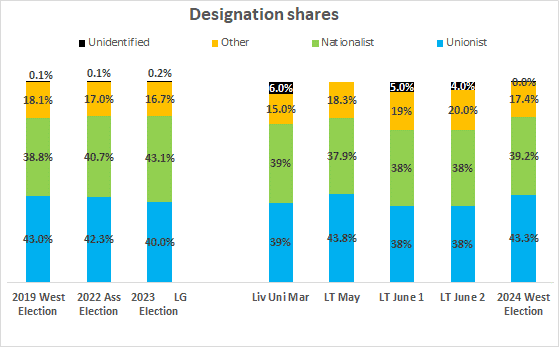

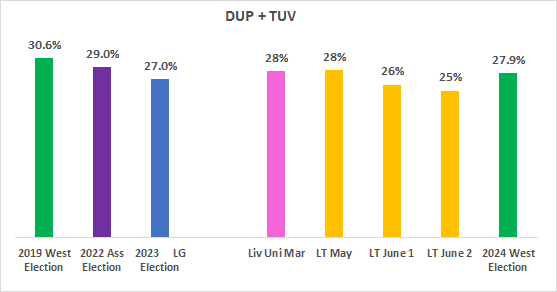

LucidTalk, in their first poll, and Liverpool both got the DUP plus TUV total on the nail.
The first LucidTalk poll was also very good on party shares, getting each within 1%. The only exception was the DUP which did 2% better at the election than shown in the poll, at the expense of the TUV. However, a DUP squeeze on TUV votes during the campaign may well have accounted for that.
Liverpool significantly underestimated the SDLP vote, and its over-estimate of the SF vote was outside the margin of error. It got Alliance spot on and was essentially correct on the UUP and TUV.
If LucidTalk had stopped after their first poll they would have scored a triumph. Unfortunately, each of their subsequent polls drifted further in the wrong direction, as can be seen in the charts below. By the final poll they were scoring Sinn Féin 4% points below their actual result (outside the margin of error) and had Alliance 3% higher than their true achievement (on the border of the margin of error).


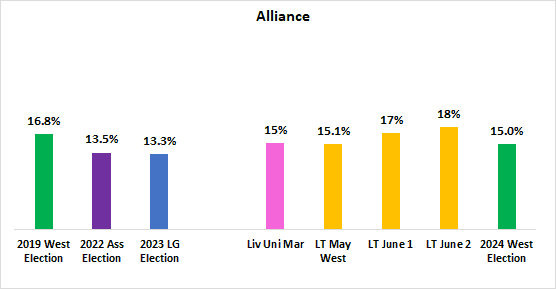

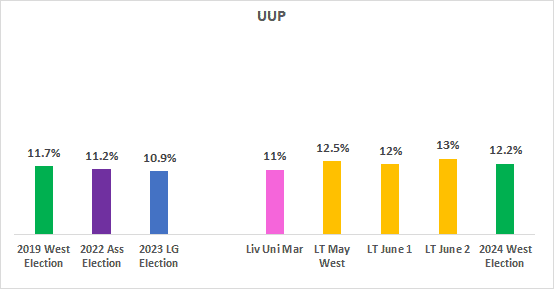

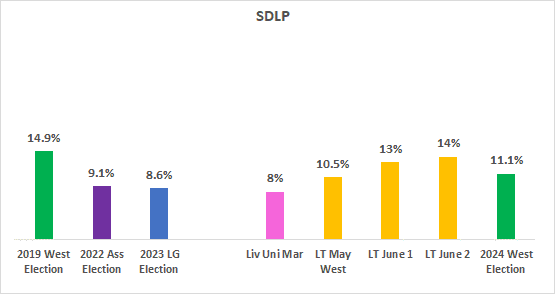

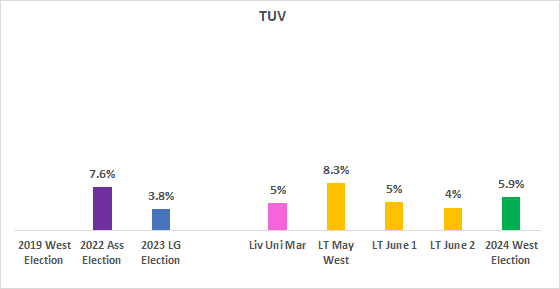

Although LucidTalk had a much better result in 2019, its 2017 result was totally off. The lesson is that Westminster polls in Northern Ireland are more likely than not to fall victim to the tactical voter.
Michael Hehir is a retired sales and marketing manager. He studied in Northern Ireland but now lives between England and Italy.
Discover more from Slugger O’Toole
Subscribe to get the latest posts sent to your email.
[ad_2]
Source link



